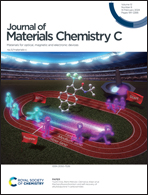Peripheral halogen atoms in multi-resonant thermally activated delayed fluorescence emitters: the role of heavy atoms in intermolecular interactions and spin orbit coupling†‡
Abstract
Multi-resonant thermally activated delayed fluorescence materials (MR-TADF) can show narrow-band emission with high photoluminescence quantum efficiency, desirable for applications in organic light emitting diodes (OLEDS). However, they frequently suffer from slow reverse intersystem crossing (RISC) compared to established donor–acceptor TADF emitters, leading to severe device efficiency roll-off at high exciton densities. Introducing heavy atom effects (HAE) by core-substitution has been previously shown to enhance spin orbit coupling and thus RISC in MR-TADF emitters, frequently with oxygen atoms replaced by isoelectronic sulfur or selenium. Here, we explore an alternate HAE strategy using peripheral halogenation of the MR-TADF DiKTa core, comparing tBr-DiKTa and dBr-tBu-DiKTa with non-halogenated Mes3-DiKTa. The two brominated emitters demonstrate improved kRISC because of the HAE, while the rate appears to improve by an additional order of magnitude in the mCP host, because of intermolecular (guest–host) interactions. Despite the beneficial hetero-intermolecular interactions, strong homo-intermolecular interactions result in enhanced non-radiative pathways and lower photoluminescence quantum yields. OLEDs of dBr-tBu-DiKTa hence showed comparable EQEmax with Mes3-DiKTa (21%) and improved efficiency roll-off until 500 cd m−2, although with accelerated roll-off beyond a critical current density. Together with comparisons in less heavily doped devices, these results show that the HAE provided by peripheral halogens improves the device performance up to 500 cd m−2, but also supports detrimental intermolecular interactions that dominate at higher device currents.



 Please wait while we load your content...
Please wait while we load your content...